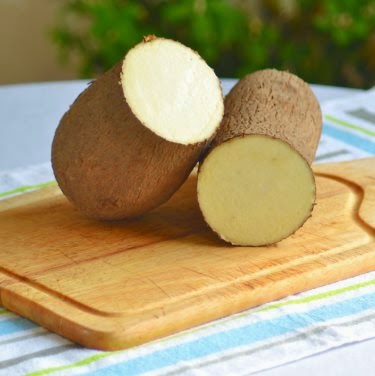 |
| Puna Yam |
First of all, Yams are not same as Sweet Potatoes! They are classified as root vegetables and they represent the main source of dietary carbohydrate in most of West Africa.
Yams come in different varieties; their variations stemming from their starch, water and fibre contents. Some degree of variation is also dictated by the region in which the yam is cultivated.
The different species of yams have a peculiar appearance by which they can be identified. These variations also determine how best to prepare and cook them.
 pic credit: flickr.com
Nutritional Benefits: Yams are rich in nutrients that help to protect the body and are hence considered to be one of the healthiest foods for human consumption.
pic credit: flickr.com
Nutritional Benefits: Yams are rich in nutrients that help to protect the body and are hence considered to be one of the healthiest foods for human consumption. They are a good source of vitamin C (though most of this reside near the skin). A medium-size yam provides 1/3 of the vitamin C recommended daily for an average adult.
Yams supply potassium, magnesium, phosphorus, and large amounts of vitamin B6, folic acid and other B vitamins. They also contain small amounts of vegetable protein are low in sodium, virtually fat free and easy to digest.
Food facts: Yams have a low-medium glycaemic index, high in dietary fibre and a source of slow release energy. They also contain a unique substance that is used as a starting material for the synthesis of the hormones oestrogen and progesterone.
Common uses: Yams can be boiled, roasted/baked or fried like their European equivalent - potatoes. They can also be dried and milled into flour.
Cooking Yams: Leaving skin on yams during cooking is an excellent way to conserve their nutrients, but yams must be thoroughly washed to remove all traces of soil. If yams are to be peeled before cooking, keep peelings as thin as possible, since some of the yam's nutrients are found close to the skin.
Storing Yams: Store yams in a cool, dry, dark place that is well ventilated. Under these conditions yams will keep well for several weeks. Warmer temperatures can encourage sprouting and shrivelling. Sprouting yams can still be used. Simply peel to remove sprouts completely before cooking. Some varieties of yams can be peeled, sliced and refrigerated/frozen but will only then be ideal for boiling afterwards. Freezing some yam varieties may cause them to darken and develop an odd bitter taste.
The most popular yam recipe among West Africans is pounded yam or yam foofoo, which is made by peeling, boiling and then pounding into a dough using traditional mortar and pestle. This is usually served with vegetable soups and stews.
Yams can also be stewed, grated and deep fried or added to complement soup or snack recipes.
There is much more you can do with yams. For instance you can make a variety of light meals and snacks that can be enjoyed for relaxation with friends and family.
Tip: Older, drier yams have a much more sweet and creamy taste and texture; perfect for pounding, boiling or stewing. Soaking them in some fresh clean water for about 20 minutes before cooking increases their moisture content and enhance texture.
Nutritional Data (Based on 100g of boiled yam)
Calories: 136.3kcal
Dietary fibre: 3.9g
Carbohydrates: 29g
Protein: 1.7g
Fat: 0.2g
Vitamins: B1 B6, C
Minerals: Potassium, Managanese